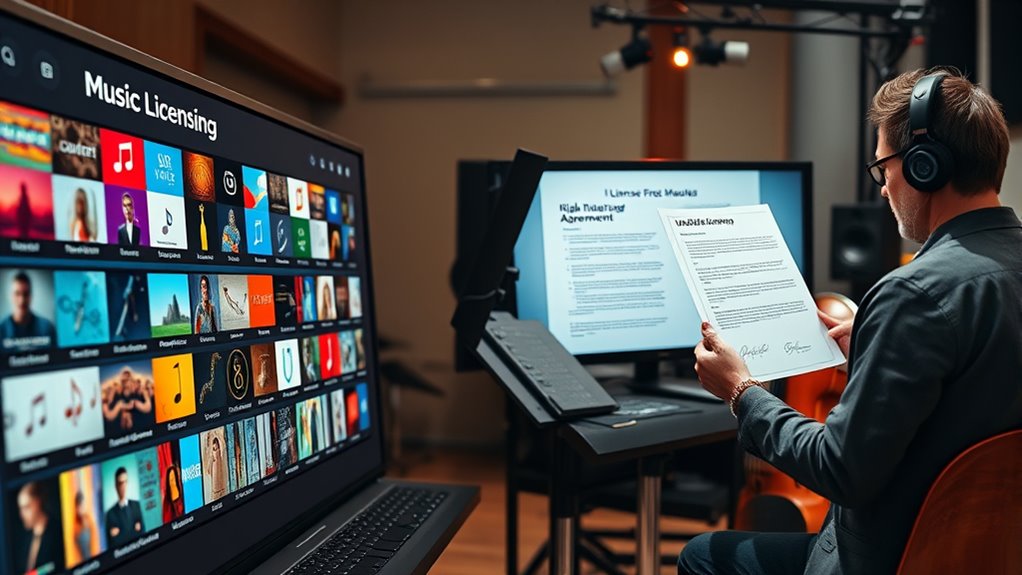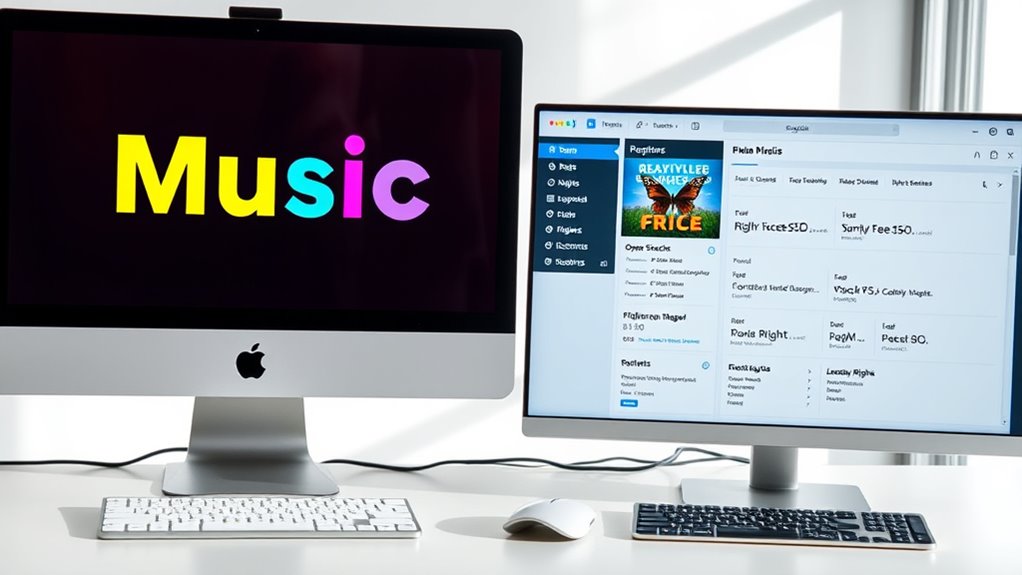When choosing stock music licenses, you’ll find two main options: royalty-free and rights-managed. Royalty-free music requires paying a one-time fee for unlimited use across multiple projects, making it cost-effective and easy to manage. Rights-managed music involves negotiating specific usage terms focused on duration, region, and purpose, often at a higher cost but with more control. Exploring these options thoroughly will help you make the best choice for your project’s needs.
Key Takeaways
- Royalty-free music requires a one-time fee for unlimited use, while rights-managed licensing is priced based on specific usage parameters.
- Rights-managed licenses offer more control and exclusivity, suitable for high-profile or commercial projects.
- Royalty-free simplifies licensing, making it accessible for multiple projects without additional fees.
- Rights-managed licenses often involve higher costs and detailed negotiations, ensuring tailored rights and restrictions.
- Understanding licensing terms helps ensure legal compliance and proper usage across different media and distribution channels.

Ever wonder how filmmakers and content creators find the perfect soundtrack without breaking the bank? The secret lies in understanding the different types of stock music licensing available, mainly royalty-free and rights-managed licenses. When you’re selecting music for your project, you must navigate the complex world of music licensing, where copyright restrictions play a significant role. These restrictions determine how you can use a piece of music, how long you can use it, and in what contexts, so choosing the right license is essential to avoid legal pitfalls.
Royalty-free music licensing is often the most straightforward and cost-effective choice for creators. Despite the name, it doesn’t mean the music is free, but rather that once you pay the initial fee, you can use the track multiple times without paying additional royalties. This model is ideal if you need flexibility and plan to use the music across multiple projects or platforms. It also simplifies the process because there’s typically less concern over copyright restrictions once you’ve purchased the license. You won’t have to worry about tracking usage or paying additional fees, making it a popular choice for YouTubers, small filmmakers, and content creators with limited budgets. Additionally, royalty-free music can often be found through a wide range of online libraries, making it accessible and convenient for various creators. Understanding licensing models can help you make more informed decisions for your projects. It’s important to recognize that licensing terms can vary between providers, so always review the specifics of each agreement.
On the other hand, rights-managed music licensing is more restrictive but offers a different level of control. With rights-managed licenses, your usage of the music is carefully negotiated based on specific parameters like duration, geographic region, and media type. This means you pay a fee that aligns with how, where, and for how long you intend to use the track. Rights-managed licenses are often used for high-profile projects, commercials, or productions where exclusivity and precise control over copyright restrictions are essential. They can be more expensive but give you peace of mind that you’re not infringing on copyright restrictions, especially in cases where the rights are tightly controlled by the copyright holder. Understanding the differences in licensing models can help you make more informed decisions for your projects.
In both cases, understanding the nuances of music licensing is essential. Not adhering to copyright restrictions can lead to legal issues, including takedown notices, fines, or even lawsuits. That’s why it’s important to carefully review licensing agreements, ensuring you have the right permissions for your intended use. Whether you choose royalty-free or rights-managed music, always read the licensing terms thoroughly. Doing so helps you stay compliant with copyright laws, avoids potential legal complications, and allows you to focus on creating great content with the perfect soundtrack, all while respecting the rights of the original artists. Additionally, being aware of music licensing restrictions can help you make more informed decisions about your projects. Remember that licensing agreements often specify restrictions related to distribution channels, so understanding these limitations can prevent unexpected issues down the line.
Frequently Asked Questions
Can I Modify Royalty-Free Music for My Project?
You can modify royalty-free music for your project, which offers great licensing flexibility. Many royalty-free tracks allow music customization, so you can alter the composition to better fit your needs. Just make sure to check the specific license terms, as some may restrict certain modifications. Overall, royalty-free music gives you the freedom to adapt tracks creatively, making it easier to tailor soundscapes to your project’s unique requirements.
How Do Licensing Fees Vary Between Stock Music Types?
You might think licensing fees are straightforward, but they actually vary based on pricing models and usage limitations. With royalty-free music, you often pay a one-time fee, making costs predictable, while rights-managed tracks typically have tiered fees depending on how, where, and how long you use the music. This complexity means your project’s scope directly influences costs, so understanding these differences helps you budget effectively and avoid unexpected expenses.
Are There Restrictions on Using Rights-Managed Music Internationally?
When using rights-managed music internationally, you face licensing limitations and potential international restrictions. You need to guarantee your license covers all countries where your project will be shown, as rights-managed licenses are often geographically restricted. Without proper international licensing, you risk copyright infringement. Always check the licensing terms carefully and consider securing global rights if your content will reach a worldwide audience to avoid legal issues.
What Are the Renewal Terms for Rights-Managed Licenses?
When it comes to rights-managed licenses, you need to know the ins and outs of license renewal and duration terms. Typically, these licenses specify a set period, often a year or more, during which you can use the music. If you want to keep using it beyond that, you’ll need to renew the license. Always check the original agreement, as renewal terms can vary, and staying proactive prevents any surprises down the road.
Can I Combine Royalty-Free and Rights-Managed Tracks in One Project?
You can definitely combine royalty-free and rights-managed tracks in one project. Just keep in mind that each type has different licensing durations and restrictions, depending on your music genre and intended use. With royalty-free music, you often get unlimited use after a single purchase, while rights-managed tracks may have specific licensing periods. Always review the licensing terms to guarantee compliance and avoid potential legal issues.
Conclusion
When choosing between royalty-free and rights-managed stock music, remember that while royalty-free offers instant access and affordability, rights-managed provides exclusivity and tailored licensing. Some believe that royalty-free music diminishes the value of composers’ work, but in reality, both options serve different needs. By understanding each licensing type’s true purpose, you can confidently select the best fit for your project, ensuring your music choice enhances your work without unexpected legal or financial surprises.









